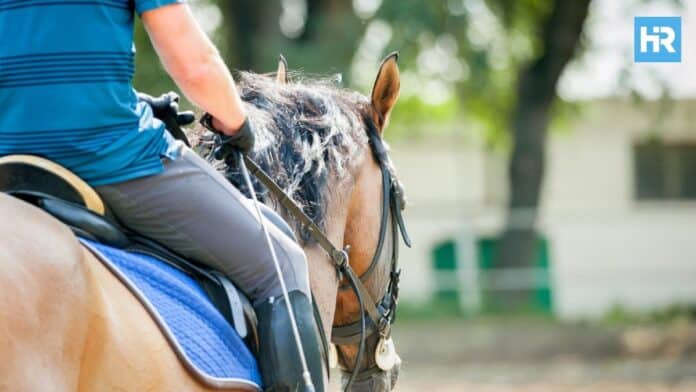Horse riding is a skill, a sport, and, for many, a passion that lasts a lifetime.
If you’re starting to explore horse riding, you’ve likely realized there’s so much more to it than you expected.
Every riding style is different, so this guide will introduce you to popular horse disciplines, including English and Western riding styles, which are some you might not know about yet.
No matter your skill level, there’s a type of riding that’s perfect for you.
- Western riding is exciting and practical. Disciplines like reining focus on smooth stops and spins, barrel racing tests speed and sharp turns, and team roping show teamwork with cattle.
- English riding is elegant and precise. Disciplines like dressage focus on control and harmony, show jumping challenges horses to jump quickly and accurately, and eventing combines dressage, cross-country, and jumping.
- Choose a discipline that fits your goals and skills. Beginners may enjoy trail riding or Western pleasure, while experienced riders can explore advanced activities like cutting, polo, or eventing.
What Are Horse Disciplines?
Horse disciplines are different activities or sports that riders and horses do together.
And they vary widely, from the precision of dressage to the thrill of barrel racing.
Some, like endurance riding, push a horse’s strength and stamina to the limit, while others, like show jumping, put agility and quick reflexes on full display.
These activities can be done for fun, as part of a tradition, or in serious competitions.
English Riding Disciplines
English riding focuses on control, balance, and building a strong connection between horse and rider.
It uses a lighter saddle, allowing closer communication between the rider and horse.
Known for its elegance and attention to detail, English riding includes a variety of disciplines, each with its unique purpose and challenges.
Dressage
Dressage, often called “horse ballet,” is about achieving harmony between horse and rider.
The horse performs a series of movements called tests that show how well-trained and responsive it is to the rider’s signals.
Movements range from simple tasks like walking and trotting to advanced maneuvers like pirouettes and flying lead changes.
The competition takes place in a 20×60-meter arena, marked with letters that guide the performance.
Judges evaluate the smoothness, precision, and grace of the routine and the connection between horse and rider.
Dressage takes years of practice, as it relies on subtle communication and perfect timing.
Show Jumping
Show jumping is a fast-paced discipline where horses and riders navigate a course of jumps and obstacles.
The goal is to complete the course as quickly as possible without knocking down obstacles or going over the time limit.
Jumps vary in height and difficulty, requiring agility, speed, and trust between horse and rider.
Riders must make quick decisions to approach each jump at the correct angle and speed, while horses must stay focused and responsive.
Mistakes, like knocking over a pole or refusing a jump, result in penalties called faults.
The winner is the pair that finishes with the fewest faults and the fastest time.
Eventing
Eventing, also known as the “equestrian triathlon,” combines three disciplines—dressage, cross-country, and show jumping—into one competition.
The dressage phase tests precision and obedience, with horses performing specific movements in a calm and controlled manner.
The cross-country phase is an outdoor course with natural obstacles like logs, ditches, and water crossings.
The final phase, show jumping, challenges accuracy and agility in a timed jumping course.
Scores from all three phases are combined, and the rider with the lowest penalties wins.
Eventing requires a versatile horse and a rider skilled in multiple areas, which is why it’s one of the most demanding equestrian sports.
Hunting
Hunting, also known as fox hunting, is a traditional sport deeply rooted in English history.
Originally, it involved chasing a fox with a pack of hounds, but today, it often uses artificial scent trails instead.
Riders travel across open fields, streams, and fences, working together to navigate the terrain.
Consequently, horses must be strong and steady to handle long distances and natural obstacles.
Hunting is also a social event, with many hunts ending in gatherings or celebrations.
Hunter/Jumper
Hunter/Jumper focuses on jumping courses designed to look like natural obstacles, such as hedges and fences.
Unlike show jumping, which prioritizes speed, Hunter/Jumper competitions judge smoothness, rhythm, and style.
Judges evaluate the horse’s form, consistency, and overall grace as they navigate the course.
Not to mention, riders are also scored on their position and technique.
Polo
Polo is a fast-paced team sport where riders use mallets to hit a ball into the opposing team’s goal.
The game is played on a large grass field, divided into six periods called chukkas, each lasting 7.5 minutes.
Polo requires quick reflexes, excellent horse control, and strong coordination with teammates.
The horses, known as “ponies,” are trained to be fast, agile, and responsive, enabling players to maneuver effectively.
Cross-Country
Cross-country is an outdoor riding discipline where horse and rider tackle a course filled with natural obstacles.
The obstacles include logs, ditches, water crossings, and uneven terrain.
Ultimately, the goal is to complete the course within a set time while clearing all obstacles safely.
Cross-country is part of eventing but is also enjoyed as a standalone activity for riders who love outdoor adventures.
Equitation
Equitation focuses on the rider’s posture, technique, and ability to communicate effectively with the horse.
Judges evaluate how well the rider maintains balance and control while guiding the horse through movements.
Equitation competitions often include flatwork, like walking and trotting, as well as jumping exercises.
This discipline is ideal for riders who want to improve their skills and develop a deeper connection with their horse.
Saddle Seat
Saddle Seat is a flashy riding style that showcases the high-stepping gaits of specific horse breeds, such as the American Saddlebred and Morgan horse.
In this discipline, the rider sits farther back in the saddle to emphasize the horse’s elevated movements and proud carriage.
Judges score the horse’s performance, the rider’s presentation, and the overall impression of the pair.
Saddle Seat is primarily practiced in the United States and is known for its showy, elegant displays.
Hunt Seat
Hunt Seat combines flatwork and jumping, emphasizing balance and freedom of movement.
Rooted in fox hunting traditions, this style focuses on a forward seat that allows the horse to navigate obstacles with ease.
It is commonly seen in Hunter/Jumper competitions and is known for promoting good riding habits and a practical approach.
Endurance Riding
Endurance riding is a long-distance discipline where horses and riders cover 50 to 100 miles of challenging terrain.
The focus is completing the ride within a set time while keeping the horse healthy and fit.
Riders must manage the horse’s pace, rest periods, and energy levels throughout the journey.
Vet checks are conducted regularly during the ride to ensure the horse’s well-being.
Endurance riding is a true test of teamwork, trust, and strategy between horse and rider.
Western Riding Disciplines
Western riding comes from the everyday work done on ranches in the American West.
Cowboys needed horses that could handle long hours, rough land, and quick moves to manage cattle.
Over time, these practical ranch skills turned into exciting competitions and fun activities.
Let’s take a closer look at the most popular Western riding disciplines and what makes each one special.
Rodeo
Rodeo is a thrilling event that shows off the skills cowboys and cowgirls use on ranches.
It includes several exciting activities like bull riding, steer wrestling, team roping, and barrel racing.
In bull riding, the goal is to stay on a bucking bull for at least 8 seconds, using just one hand.
Steer wrestling, also known as bulldogging, involves jumping off a horse to wrestle a steer to the ground as fast as possible.
Team roping is about teamwork, where one rider ropes the steer’s head while the other ropes its legs.
In barrel racing, riders guide their horses around three barrels in a cloverleaf pattern as fast as possible.
Knocking over a barrel adds penalties, so speed and precision are key.
Reining
Reining is a Western discipline where horses perform a set pattern of moves with control and grace.
The moves include spins (pivoting in one spot), sliding stops (dramatic halts), and rollbacks (quick 180-degree turns).
And the patterns are based on tasks horses would do on a ranch, like turning sharply to keep up with cattle.
Horses are judged on how accurate and smooth their movements are and how willingly they follow the rider’s signals.
Reining is often called the Western version of dressage because it highlights the connection between horse and rider and requires fine control.
Cutting
Cutting is a sport where horses show off their natural ability to separate a cow from the herd.
The rider chooses a cow and guides the horse to cut it out of the group.
Once the cow is separated, the rider drops the reins, and the horse takes over. Then, the horse uses its instincts to keep the cow from returning to the herd.
Judges score the horse on how quickly and confidently it reacts to the cow’s movements.
Cutting started as a ranch skill but has become a fast-paced and exciting competition.
Barrel Racing
Barrel racing is one of the fastest and most exciting Western events.
Horses race through a cloverleaf pattern around three barrels, trying to finish in the quickest time.
The rider and horse must make tight, precise turns around each barrel without knocking them over, which adds penalties.
Barrel racing requires a horse that’s fast and quick to respond to the rider’s commands.
It’s a staple of rodeos and a crowd favorite because of its thrilling speed and sharp turns.
Western Pleasure
Western pleasure shows how calm and smooth a horse can be while performing different gaits.
Horses are judged on their ability to walk, jog (a slow trot), and lope (a slow canter) in a relaxed and steady manner.
The goal is to make the ride look effortless and enjoyable, with the horse appearing happy and willing.
Riders guide their horses using gentle signals, showing off their ability to work as a team.
Trail Riding
Trail riding is a discipline that mimics the challenges riders face when out on real trails.
Horses navigate over logs, through water, and around tight spaces, all while staying calm and controlled.
Judges look at how smoothly the horse handles each obstacle and how effectively the rider guides them.
Ranch Riding
Ranch riding shows off the skills a horse and rider would need for daily ranch work, including moving cattle, opening gates, and navigating rough terrain.
Horses are judged on their ability to work efficiently and naturally without unnecessary fuss.
Pole Bending
Pole bending is a timed event where horses weave in and out of a row of poles spaced 21 feet apart.
The whole point is to complete the pattern as quickly as possible without knocking over any poles, which adds penalties.
This sport tests the horse’s agility and the rider’s ability to guide them through sharp turns and quick movements.
Ranch Sorting
Ranch sorting is a team event where two riders work together to move specific cattle from one pen to another.
The cattle are numbered, and the riders must move them in the correct order without letting any others sneak through.
This sport requires excellent communication between the riders and a quick, focused, and responsive horse.
Choosing the Right Horse Discipline
Picking the right horse discipline depends on your goals, interests, experience, and what’s available near you.
Each discipline offers something special, and finding the one that fits you and your horse can make riding more fun and rewarding.
Start by thinking about your experience level.
If you’re new to riding, you might enjoy starting with something relaxed like trail riding or Western pleasure.
That said, if you’re more experienced, you might prefer something challenging like eventing, reining, or show jumping.
Next, consider what excites you most.
If, say, you enjoy calm, precise riding, dressage or reining could be the best fit.
But perhaps speed and action are more your style; if so, barrel racing or show jumping might be a better fit.
If you like working with a team, try disciplines like polo or ranch sorting.
However, one of the biggest factors is your fitness level and how much time you can spend training.
Disciplines like endurance riding or eventing require both you and your horse to be in great shape and ready to practice a lot.
So, if you’re looking for something more relaxed, equitation or Western pleasure could be just right.
Another thing is that you’ll need to look into what’s available near you.
Some disciplines, like polo or cutting, need special facilities, equipment, or even specific types of horses.
So, check local stables or riding centers to see what lessons or programs they offer.
Lastly, consider your horse’s abilities and personality.
There are horses that are naturally better at certain disciplines.
Strong, muscular horses, for instance, might do well in barrel racing or cutting, while taller, more elegant horses may excel in dressage or jumping.
Whatever you choose, remember that the goal is to have fun, learn new skills, and build a strong bond with your horse.
Every discipline has its own rewards, so take your time, explore your options, and find the one that makes you happiest.






